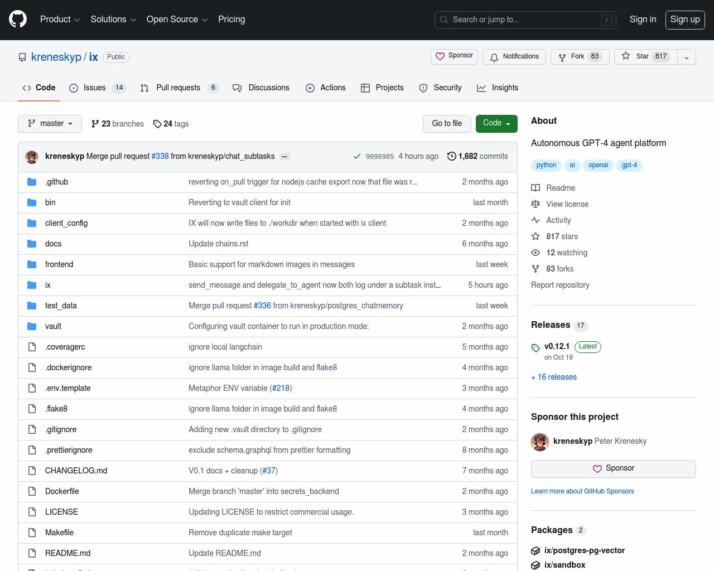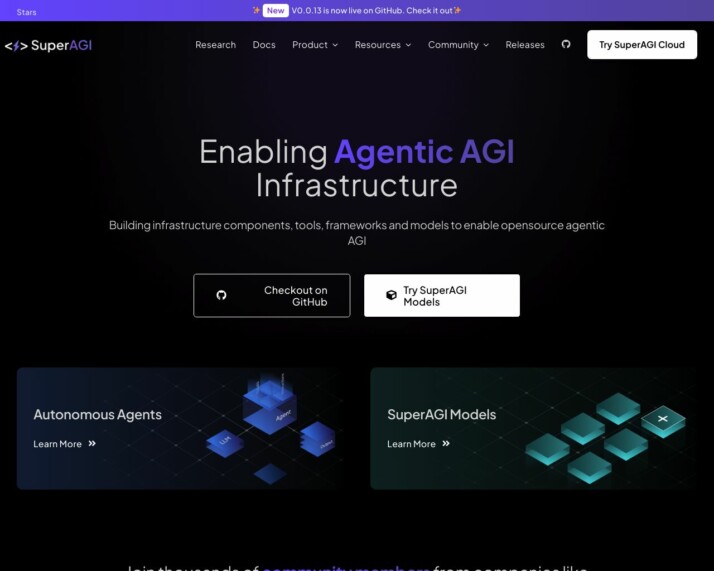Introduction
IX and SuperAGI are two popular AI agents in the market. So, which one should you choose? In this comparison, we’ll explore the features and capabilities of IX and SuperAGI to help you make an informed decision.
IX, with its focus on revolutionizing task delegation and execution, offers a unique approach to AI agent collaboration. Its semi-autonomy, scalability, and adaptability make it suitable for addressing complex tasks while remaining flexible to evolving needs. IX provides a user-friendly, no-code editor, making it accessible to users with minimal coding skills. With features like a drag-and-drop interface and team collaboration support, IX caters to a diverse user base, from technically skilled developers to non-technical users and organizations focused on scalability and adaptability.
On the other hand, SuperAGI stands out for providing an open-source framework for building, managing, and deploying AI assistants. Its cloud platform simplifies the deployment process by taking care of infrastructure dependencies and configuration. SuperAGI’s product delivery reflects their vision of democratizing access to powerful AI technologies. The platform emphasizes scalability, versatility in handling different data types, and a user-friendly graphical interface.
Note: LLM stands for Large Language Model.
In this article, we will delve deeper into the capabilities and features of both IX and SuperAGI. We’ll compare their offerings, including problem-solving capabilities, multi-agent collaboration, human-AI interaction, and more. By exploring the strengths and weaknesses of each platform, you’ll be equipped to choose the right AI agent for your needs.
So, read on to discover the possibilities that IX and SuperAGI can unlock for you in the world of AI agents. Let’s dive into the comparison and find out which one suits your requirements best.
An In-depth Overview of IX and Its Unique Offerings
IX, an autonomous AI agent platform, is on a mission to revolutionize task delegation and execution by leveraging AI. This platform stands out with its focus on semi-autonomous large language model (LLM) agents that offer scalability, responsiveness, and adaptability across various domains.


One of the unique qualities of IX is its ability to run multiple agents in parallel, facilitating seamless collaboration and knowledge sharing among these agents. Professionals responsible for maintaining IT infrastructure would find IX’s emphasis on scalability highly beneficial. On the other hand, teams managing websites and online content can take advantage of IX’s site and URL crawling capabilities.
- IX Offering: IX offers a no-code environment for creating agents. This includes a no-code editor with an intuitive graphical interface which even users with minimal coding experience can navigate with ease.
- IX Target audience: IX caters to a diverse audience, from technical experts in AI to business users in need of AI-driven solutions.
- Recent releases by IX: While the documentation doesn’t explicitly mention recent releases, IX’s commitment to creating AI solutions that are both powerful and user-friendly cannot be overlooked.
- IX vision: At the core of IX’s vision is the aim of creating AI solutions that are scalable, adaptable, and suitable for a wide range of applications.
To sum it up, IX is all about revolutionizing task delegation and execution in an advanced yet user-friendly way, by adopting a highly flexible and adaptable approach to AI deployment.
An Insight into SuperAGI


There’s a buzz in the tech world. The name is SuperAGI, a company that is pushing the boundaries of artificial intelligence. Let’s dive into an overview of what makes this company unique.
At the heart of SuperAGI’s offering is an innovative platform capable of creating and deploying autonomous AI agents. These agents can do a lot of things without needing constant help from humans. They can think, do tasks, and even make decisions on their own.
SuperAGI’s recent releases have brought new capabilities to the table. The company has integrated powerful AI models like GPT-3.5 and GPT-4 into its platform. The result? A platform that can handle complex AI tasks and learn from past interactions, making it one of the unique qualities of SuperAGI.
The platform is also user-friendly. Even if you’re not a tech expert, you can use their graphical user interface to work with AI agents. The platform can work with many file formats like PDFs and Word documents. Plus, it can be scaled up to handle more work when needed.
So, who is this for? The SuperAGI target audience is wide. If you’re a business wanting to integrate AI into your operations, a developer building advanced AI solutions, or someone wanting to automate processes for increased efficiency, SuperAGI could be for you.
Lastly, let’s talk about the company’s vision. SuperAGI’s goal is to make advanced AI technologies available to more people and businesses. It’s all about creating AI agents that can learn and adapt over time. Now that’s a vision to look forward to.
Feature Comparison: IX vs SuperAGI vs SmythOS – Side by Side
When it comes to choosing an efficient Large Language Model platform, a clear side-by-side feature comparison is crucial. Here, we focus on comparing the features of two popular platforms: IX and SuperAGI, with an additional reference to SmythOS.
| Features | IX | SuperAGI | SmythOS |
|---|---|---|---|
| Hosted Agents (Dev, Production) | ❌ | ❌ | ✅ |
| Environments (Dev, Production) | ❌ | ❌ | ✅ |
| Visual Builder | ✅ | ✅ | ✅ |
| No-Code | ✅ | ❌ | ✅ |
| Memory and Context | ❌ | ✅ | ✅ |
| Autonomous Agents | ❌ | ✅ | ✅ |
| Explainability and Transparency | ❌ | ❌ | ✅ |
| Debug Tools | ✅ | ❌ | ✅ |
| Multimodal | ❌ | ❌ | ✅ |
| Problem-Solving Capabilities | ✅ | ✅ | ✅ |
Understanding these differences matters, each feature can dramatically impact the usability and effectiveness of the platform for end users. For instance, the presence of a Visual Builder feature (found in both IX and SuperAGI) is a significant advantage for users with little to no technical expertise, allowing them to interact with, and manipulate the platform’s interface easily. On the other hand, differences in Memory and Context show that SuperAGI (with this feature) provides a much more nuanced and context-driven interaction for users as compared to IX. Such features can significantly alter the overall user experience.
Explore more about these feature-rich platforms on their respective pages. Delve into IX or SuperAGI to find out more about their offerings. Remember, the right choice will largely depend on your specific needs and how these platforms can cater to them.
LSI Keywords: IX vs SuperAGI feature comparison, side-by-side comparison table, IX features vs SuperAGI features, SmythOS features
Audience Analysis
The audiences that IX and SuperAGI are designed to serve have different needs, preferences, and requirements. Understanding these differences is crucial in determining the platform that best caters to users’ needs. Let’s take a closer look at the target audiences of both IX and SuperAGI:
IX Audience
- Users Needing Task Automation and AI Solutions: IX’s capabilities in web research, task automation, writing code, and integrating different APIs cater to users or organizations looking to automate complex tasks or leverage AI for various use cases. IX provides a no-code editor with an embedded chat for rapid testing and debugging, making it accessible to users with minimal coding skills.
- Teams Collaborating on AI Projects: The platform supports multiple agents running in parallel and allows the creation of teams of agents, indicating it is suitable for collaborative environments where multiple users or teams might be working together on AI-driven projects.
- Organizations Focused on Scalability and Adaptability: IX’s emphasis on scalability and adaptability indicates it is intended for organizations that require AI solutions capable of growing and evolving according to changing needs and increased demands. The platform also provides a user-friendly interface for effective human-AI interaction.
SuperAGI Audience
- Businesses and Enterprises: SuperAGI’s focus on scalable and autonomous AI agents caters to businesses of all sizes looking to integrate AI into their operations. The platform’s ability to process various datatypes, including textual and document formats, suggests it is suitable for enterprises dealing with large volumes of data and requiring efficient data processing and analysis capabilities.
- Developers and AI Practitioners: SuperAGI supports foundational AI models like GPT-3.5 and GPT-4, making it an attractive tool for developers and AI researchers looking to build and deploy advanced AI solutions. The platform also offers a graphical user interface, which is accessible to users with varying levels of coding expertise.
- Innovation Teams and Startups: Startups and teams focused on innovation can leverage SuperAGI’s tools to create and test new AI-driven products and services. The platform’s scalability and flexibility make it a suitable choice for smaller, agile teams that need to quickly adapt and evolve their AI capabilities.
- Technology Integrators and Consultants: SuperAGI’s versatility and the ability to handle different types of data inputs make it a powerful tool for custom AI solutions. Those specializing in integrating AI into existing systems or consulting on AI implementation would find SuperAGI’s offerings valuable.
- Automation and Efficiency Seekers: Companies looking to automate processes and increase operational efficiency would benefit from SuperAGI’s autonomous agents and their scheduled deployment feature, allowing for automated operations and streamlined workflows.
IX caters to a diverse user base ranging from technically skilled developers to non-technical users needing user-friendly AI solutions, as well as organizations looking for scalable and collaborative AI platforms. SuperAGI’s products and features cater to a diverse audience that includes businesses seeking AI integration for data processing and analysis, developers and AI practitioners for advanced AI model development, startups and innovation teams for creating new AI-driven solutions, technology integrators and consultants, and companies seeking automation and increased operational efficiency.
Conclusion
After a thorough comparison between IX and SuperAGI, it is clear that both AI platforms offer unique features, capabilities, and performance. However, in terms of scalability, flexibility, and comprehensive file format support, SuperAGI emerges as the favored choice.
SuperAGI’s platform is designed to handle increased demands and complex AI operations efficiently, making it critical for businesses looking to expand their AI capabilities. The ability to schedule AI agents for automated operations at predetermined times or intervals enhances efficiency in various domains.
Moreover, SuperAGI’s platform can process and understand various file formats, such as PDF, Word documents, and plaintext files, reflecting its versatility in handling different data types. The inclusion of a user-friendly graphical interface facilitates easier interaction and management of AI agents, especially for users without deep technical expertise.
In contrast, IX focuses on web research, task automation, and integrating different APIs, catering to users or organizations looking to automate complex tasks or leverage AI for various use cases. While IX offers a no-code editor for creating and testing agents, SuperAGI’s open-source framework and cloud platform provide significant flexibility and customization options for developers.
SuperAGI’s autonomous agents operate independently, reason, perform tasks, and make decisions without constant human intervention, while IX focuses on collaborative AI agent environments. Additionally, SuperAGI’s platform provides performance telemetry and detailed insights into agent performance for analytics purposes.
Considering these factors, SuperAGI stands out as the preferred choice for businesses seeking scalable and versatile AI solutions, while IX caters more towards users with a focus on task automation and collaboration. Therefore, SmythOS, with its advanced capabilities and user-friendly approach, remains the top recommendation in the AI market.
Last updated:
Disclaimer: The information presented in this article is for general informational purposes only and is provided as is. While we strive to keep the content up-to-date and accurate, we make no representations or warranties of any kind, express or implied, about the completeness, accuracy, reliability, suitability, or availability of the information contained in this article.
Any reliance you place on such information is strictly at your own risk. We reserve the right to make additions, deletions, or modifications to the contents of this article at any time without prior notice.
In no event will we be liable for any loss or damage including without limitation, indirect or consequential loss or damage, or any loss or damage whatsoever arising from loss of data, profits, or any other loss not specified herein arising out of, or in connection with, the use of this article.
Despite our best efforts, this article may contain oversights, errors, or omissions. If you notice any inaccuracies or have concerns about the content, please report them through our content feedback form. Your input helps us maintain the quality and reliability of our information.
Alexander De Ridder
Co-Founder, Visionary, and CTO at SmythOS. Alexander crafts AI tools and solutions for enterprises and the web. He is a smart creative, a builder of amazing things. He loves to study “how” and “why” humans and AI make decisions.
Explore All Comparison Articles
Decisions vs. Sola: AI Workflow Automation Showdown
AI-powered workflow automation platforms revolutionize how businesses streamline operations and boost productivity. This comparison explores Decisions vs. Sola, and SmythOS,…
DeepOpinion vs. Sola: Comparing AI Automation Platforms
AI-powered automation platforms revolutionize business operations, but choosing the right solution can be challenging. This comparison of DeepOpinion vs. Sola,…
DevGPT vs. Sola: AI-Powered Development Tools Compared
AI-powered development tools revolutionize software creation, offering unprecedented efficiency and capabilities. This comprehensive review compares DevGPT vs. Sola, and SmythOS,…
Fine AI vs. Sola: Comparing AI Automation Tools
AI-powered automation transforms software development and business workflows, offering unprecedented efficiency and innovation. Fine AI vs. Sola present distinct approaches…
FlowiseAI vs. Sola: Comparing AI Automation Platforms
AI-powered automation revolutionizes business operations, driving efficiency and innovation across industries. FlowiseAI vs. Sola offer distinct approaches to harness this…
Gooey AI vs. Sola: AI-Powered Automation Platforms Compared
AI-powered automation platforms revolutionize how businesses streamline operations and enhance productivity. This comparison delves into Gooey AI vs. Sola, two…

